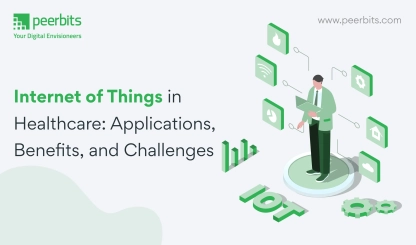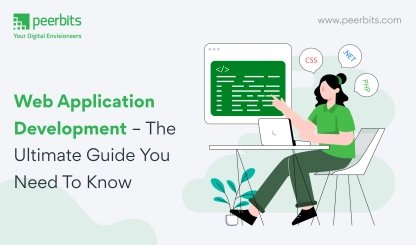Digital industrial transformation, contrary to popular belief, is not simply a word in everyone’s mouth but rather something that can completely revolutionize how an industry operates. While much emphasis is on cost reduction, it is critical for many industries like manufacturing. Because it helps them gain insights from a vast number of data generated by each step to provide excellent customer service and experience.
One of the most significant and growing digital transformation technologies is the Internet of Things or IoT. In truth, it’s not just one technology, as many people believe, but a complex system of technological and other components.
The impact of the Internet of Things on industrial automation is influential and broad when compared to other digital transformation technologies. It enables cyber-physical digital transformation strategies, commercial creation and changes possibilities, and advances in the ways people work, live, enjoy themselves, and connect. This is certainly the case in IoT and it can change the way we live.
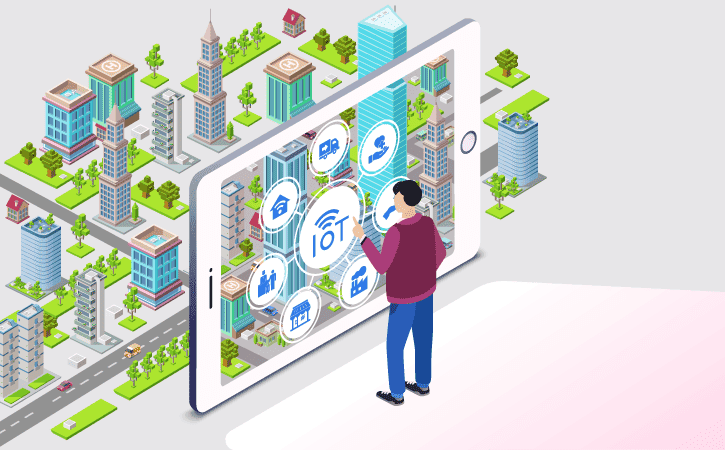
The industry’s structural changes tend to produce new value and ensure that communication and content services are digitized. The digital transformation with Internet of Things (IoT) is possible in 2022 as there are means to achieve ends — from technology to applications and even talent who can help you get started.
To do this, it is necessary to re-invent and adjust existing processes, systems, business models, and product development strategies using digital technologies. Remember that even 1% profit may make a huge difference for a manufacturing company, so think about what your company could gain by 10-20% with the appropriate strategy and digital transformation solutions.
According to Alfonso Velosa, research vice president and analyst for IoT at Gartner, IoT will continue to grow at a pace of more than 30% over the next few years. According to IDC, the research conducted by Statista Research Department, by 2025, the overall number of IoT devices will increase to 75 to 80 billion.
Industrial IoT solutions will continue to expand in device counts and users, but businesses must address the security and interoperability issues that have dogged the market since its inception.
Internet of things (IoT) and digital transformation
In information technology, digital transformation is a developing and continually expanding trend. Around 70% of companies already have a digital transformation plan to help them compete in any industry.
By 2025, analysts expect that there will be over 55.7 billion linked IoT devices, with data created from IoT devices exceeding 73.1 ZB, according to IDC. By 2022, the global Industrial Internet of Things (IIOT) market is expected to exceed $1 trillion, making it one of the most important factors in implementing a digital strategy.
Many startups like Inspirit-IoT, Helium and others have built their whole business strategy on the IoT product line. For instance, consider how Traditional businesses in various industries can benefit from incorporating developing IoT technologies and leveraging IoT app development into their existing business strategies.
Let’s start with the basics before moving on to IoT applications in various sectors.
How does the Internet of Things (IoT) work?
Industrial IoT company solutions contain several types of forms and sizes. And they might be useful across a whole organization to help businesses achieve their digital goals.
These include revolutionizing back-office processes with IoT software development, using industrial IoT applications IoT to enhance internal performance like on the shop floor, empowering and enhancing the workforce, and using industrial IoT platforms to improve internal performance like on the shop floor.
This technology is also helpful to the more client-facing aspects of the organization, like integrating IoT in goods to improve customer service and collect important customer data.
But which of these industries IoT applications have piqued the interest of businesses operating around the globe? Where are their IoT expenditures going? And what are the benefits they hope to accomplish with IoT? IoT applications might be classified into two categories.
The first tries to improve a company’s internal capabilities, while the second strives to improve a company’s external customer-facing skills.
Let’s look at some of the sectors that might benefit from IoT.
IoT Use Cases in Different Industries
Many different industries aim to hire an industrial IoT software development company to get started with the new technology in their existing scheme of working.
The industrial IoT digital transformation helps simplify tasks while driving efficiency. Here are some of the top sectors implementing IoT in their everyday tasks and staying ahead of the competition.
Internet of things (IoT) in logistics
Are you finding it troublesome to keep track of and manage your inventory? Are you losing money due to this? IoT apps might be useful to you in managing your inventory by offering some automated control choices.
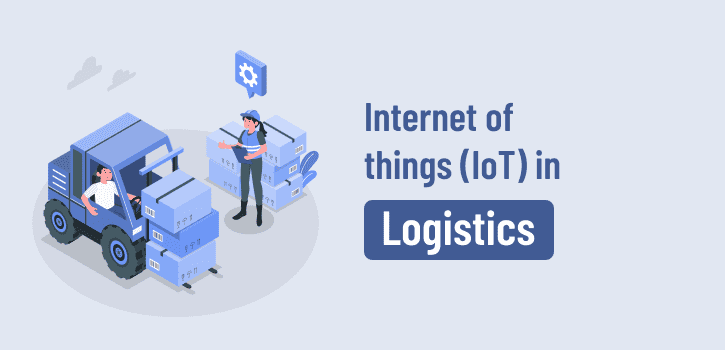
Likewise, you can leverage IoT as a part of asset tracking solution and use it in supply chain and logistics
Transparent inventory monitoring may be accomplished via several means. In contrast to regular barcodes, smart labels and RFID tags provide a far wider range of possibilities in terms of automation and analytics.
These IoT-powered approaches employ microchips that may hold all the details regarding the product you require and be updated in real-time with GPS vehicle tracking system. for total inventory visibility.
There are many benefits of Installing IoT in logistics, especially in your warehouses and storage units that might help you keep track of inventory fluctuations with IoT to real-time information monitoring techniques.
In addition, integrating surveillance systems with IoT and analytics can prevent theft before it occurs.
Example of IoT in logistics – Amazon increases its delivery capacity by using Wi-Fi robots to scan QR codes on its merchandise and track orders.

Internet of things (IoT) in healthcare
IoT technology in healthcare improves patient-doctor communication through remote monitoring and virtual visits. It assists hospitals in tracking patients and healthcare workers.
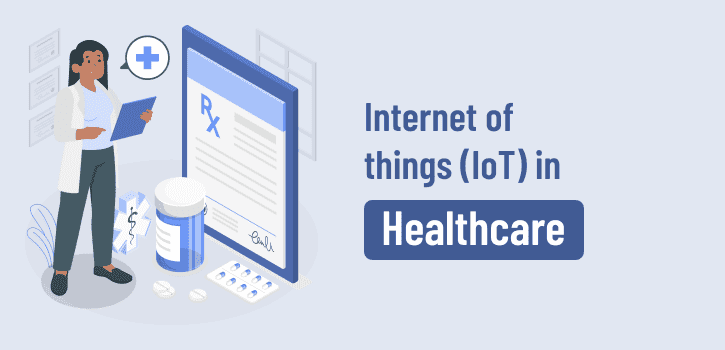
Not only that, IoT healthcare devices aid in chronic illness management. IoT can also automate the patient care workflow when hospitals and doctors adopt.
It can cull, analyze, and transfer data to keep everyone in the loop. IoT can decrease inefficiency and errors, which leads to better optimization. Patients, in some cases, don’t even need to go to the hospital.
A common use case is using healthcare and the Internet of Things. (IoT) for remote health monitoring that help reduce the cost of patients visiting hospitals for checkup.
Read more: IoT in healthcare: applications, benefits, and challenges
Example of IoT in healthcare — SystemOne transmits medical diagnostic data in real-time to physicians within minutes. They are able to do so with the help of Vodafone’s global IoT network and Managed IoT Connectivity Platform.
It allows them to stay connected with patients and manage public health situations like infectious diseases more effectively.
Internet of things (IoT) in energy
IoT technology can help the grid integrate more scattered resources while helping with grid management in other ways. Smart energy IoT solutions. include installing sensors at substations and along distribution lines to offer real-time data on power use.
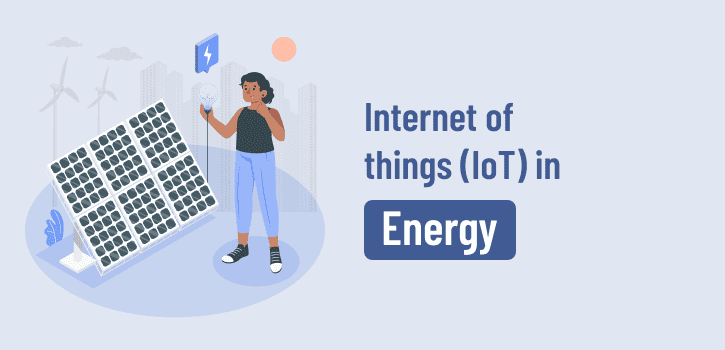
IoT based management systems can use it to make choices regarding voltage management, load switching, network layout, and other things. Some of these choices can be created automatically.
Data on power use might also be used to anticipate load. It can aid in the management of congestion on transmission and distribution lines and ensure that all linked generating units satisfy frequency and voltage control standards.
This data on power use may also assist businesses in determining where to develop new infrastructure and improve existing equipment.
As a result of the Internet of Things (IoT), improved decision-making tools may be amortised across the value chain (such as artificial intelligence or automatic learning). These decisions can also be carried out remotely and automatically.
The four functionalities of these technologies are grouped into a control loop.
- This includes things like the generation and transmission of electricity.
- Sensors are used to keep tabs on the progress and results of the physical process with IoT applications in smart energy.
- Independent and decentralised decision-making, or collaboration with other energy components.
- The actuators on the network are tasked with putting the choices into action.
Example of IoT in energy — Duke Energy, a Florida-based electric power holding corporation, claims to have developed a self-healing grid system based on IoT that would automatically rearrange itself when there is a power cut in the home.
Internet of things (IoT) in manufacturing
Manufacturing plants may benefit from the Internet of Things in various ways. It can help a manufacturing plant’s production flow since IoT devices can automatically monitor development cycles and manage warehouses and stockpiles using RFID inventory tracking.
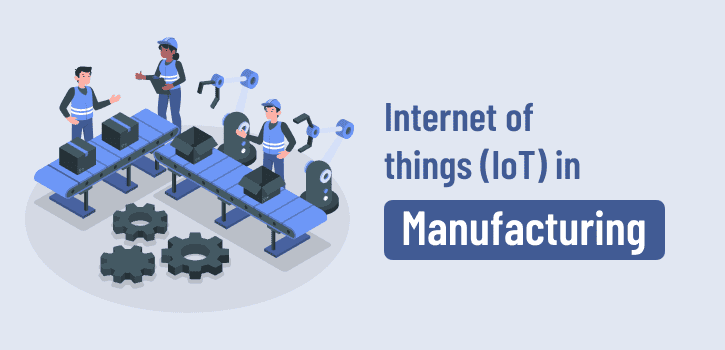
It’s one of the reasons why IoT device investment has risen in recent decades for applications of IoT in the manufacturing industry.
Predictive maintenance using industrial IoT solutions for smart manufacturing and data analytics help manufacturers avoid these unproductive processes. They can monitor the equipment’s working environment and do analytics on associated data in the cloud using IoT sensors (on the equipment).
This allows them to assess the real wear and tear. The maintenance process is more efficient, field personnel are better used, downtime is reduced, and overall costs are reduced when problems are addressed quickly.
One of the other benefits of IoT in the manufacturing industry is the use of thermal and video sensors that help capture entire product data at various points in a product development cycle. At each production stage, the items may be checked to ensure that all of their characteristics are as specified.
Manufacturing equipment instrumentation and monitoring aid quality control staff in determining if and where calibration deviates from standard settings; these errors must be resisted in time to prevent misalignment of goods.
Example of IoT in manufacturing — The IoT has resulted in some unexpected ‘things’ becoming connected to the Internet, things you wouldn’t expect to be helpful once online.
That ‘thing’ is an elevator for CGI, a major technology corporation who adopted an IoT-based asset management solution. The firm has partnered with Microsoft to provide a predictive maintenance solution for ThyssenKrupp Elevator elevators.
Internet of things (IoT) in retail
With the rise of IoT in the retail industry, many businesses are witnessing growth in revenue with wider reach. It’s no surprise that the IoT in the retail sector is predicted to reach USD 182.04 billion by 2028, with 70% of retailers believing that IoT would greatly influence how they do business in the future.
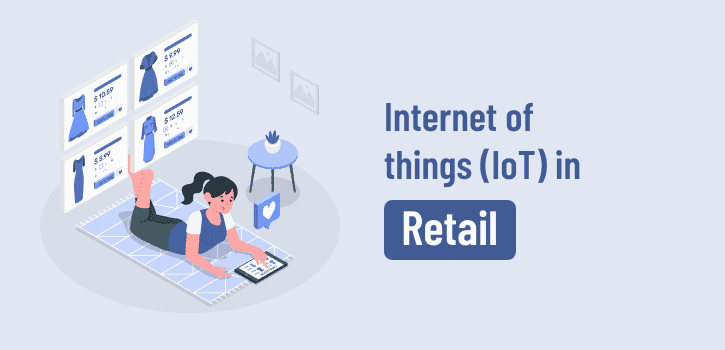
As a way to improve customer satisfaction, retailers are turning to smart retail IoT applications. that offer a cohesive shopping experience to buyers. An IoT sensor dashboard or set of color-coded buttons enable retailers to gather client feedback right after the shopping experience. In-store consumer happiness may be enhanced by using this data in real-time.
Consumer habits, high delivery service demand, customers’ fear of online transactions, and a lack of digital proficiency are all issues that keep merchants from succeeding in an environment where they could otherwise thrive.
Smart retail promises to address these issues by providing merchants and their consumers with unparalleled benefits, including revenue growth, cost reductions, and business process efficiencies.
Example of IoT in retail — Disney World has unveiled its first IoT-enabled wearable MagicBand to improve service, manage lines, automate payment, and manage guests, among other things.
Today’s MagicBand provides visitors with various capabilities that allow them to immerse themselves in thrilling immersive experiences at Disney World.
Internet of things in hospitality
Every visitor who stays at an IoT-enabled hotel may use a wide range of services. The significant increase in luxury makes their trip memorable. Furthermore, with IoT deployment in the hotel industry, these facilities appear to be a free upgrade.
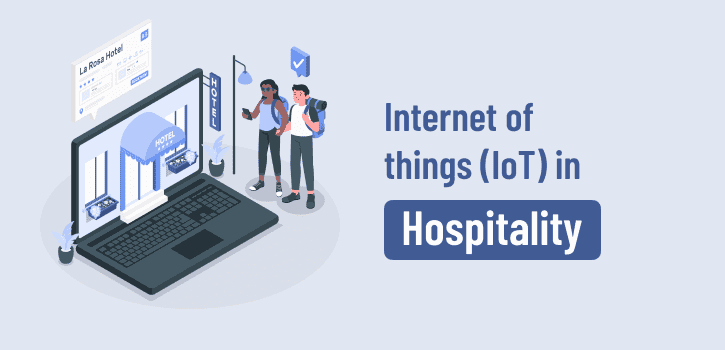
Checking in and out and individualized setting-up of a subject of great prestige is a priority.
Guests and hotel staff alike benefit from IoT-connected devices in a smart hotel, which streamlines operations for everyone involved. The hospitality industry offers a wide range of automation solutions that can be used to enhance smart hotel rooms.
It’s a win-win situation for everyone involved: guests have more convenience and comfort, hoteliers save money.
This technology’s potential extends well beyond the scope of this article. A guest’s electronic key may be automatically sent to their phone an hour before check-in time, sync the door with the check-in desk, and enable visitors to skip the check-in desk totally and walk right to their room using internet communication technology, which is currently being developed.
The Internet of Things (IoT) makes automation and real-time data more accessible. It is critical for providing end-to-end IoT solutions to clients to provide first-class tailored services and a better visitor experience.
Example of IoT in hospitality – The IoT-enabled Le Meridian Goa, Calangute, has created a hotel that saves energy while providing an amazing guest experience. Schneider Electric’s IoT hotel solution helped them achieve this.
Internet of things in home automation
The term home automation refers to the automation of a home, often known as a ‘smart home.’ You can manage your gadgets like lights, fans, and televisions through the IoT home automation ecosystem.
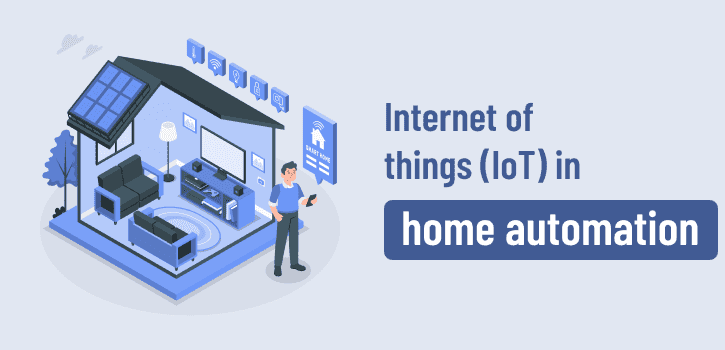
The IoT technology utilizes data that keeps tabs on, manages, and sends data to other devices through the net. This enables pre-programmed actions to be triggered when certain conditions are met.
Consider, for the sake of illustration, a smart kettle. When the kettle reaches a certain temperature, it may be set to shut off automatically. The user may also get a notice about the same.
Incorporate the same idea across the whole house and all of its gadgets. That is an Internet of Things (IoT)-enabled smart house. A button push instead of a physical interaction with a widget may accomplish the same task.
Most smart IoT home automation. devices can now be controlled via an app or even voice commands utilizing Amazon Echo or Google Home.
Example of IoT in home automation — Smart LG fridges allow you to pre-order extra ice production while you’re still shopping for party supplies at Target or check expiry dates on items to help you optimize your shopping list.
Advantages of IoT for industries
Entrepreneurs may greatly benefit from digital transformation by improving their services and consumer experience. Let us now consider the advantages of digital industrial transformation with the Internet of Things.
Better CX
Tech-savvy customers nowadays want advanced and real-time support to address their problems. They are constantly on the lookout for sophisticated technologies that will make their life easier.
As a result, businesses must develop digital solutions based on cutting-edge technology to provide a better experience for their consumers.
Robust security
Digital methods are more secure and resilient than old ones. Organizations may use digital transformation solutions to safeguard their private and important data more efficiently and securely. It can assist them in preserving data and gaining client confidence over time.
Opens up new business opportunities
Organizations may better understand their clients’ needs by leveraging data provided by IoT devices that thrive on IoT app development. They can adjust their product offers accordingly and introduce new products or services to cater to a larger audience.
Improves operational efficiency
Industrial IoT solutions coupled with software and mobile applications. can increase company efficiency by automating processes by combining rich data experiences with autonomous sensors.
Stock management, logistic management, security, energy maintenance, and so on are only a few of the important activities that may be optimized.
Reduces the operational costs
Process automation will inevitably save you money and help you better use your resources. IoT energy solutions, for example, may help you manage utility use and trash disposal. This technology may improve heating, ventilation, air conditioning systems, lighting and water delivery.
Boosts employees’ productivity
IoT, like cloud and mobile technology improvements, may help you engage your employees, improve agility, and make your company system available from anywhere at any time. Smart sensors may keep employees connected at all times and deliver real-time experiences, resulting in increased productivity.
Bottomline
Businesses use new IoT technology to operate smarter by connecting equipment and providing real-time information to consumers and workers, resulting in a more customized and fulfilling experience. Secure integration into corporate processes and workflows is possible with IoT transformation.
It might be scary to jump on the IoT bandwagon. However, if your company is aware of the effect and influence of popular digital technologies, you know it’s time to make the switch.
The IoT holds a lot of potential and promise in the upcoming future. However, if you want to use it for digital transformation, make sure you do it intelligently.
Engaging in a strategic collaboration with an IoT provider who knows how to drive digital transformation with IoT disruption would be the most optimal and cost-effective strategy.
It is recommended that businesses have their technology stack to prepare for emerging technologies like IoT and digital transformation.


